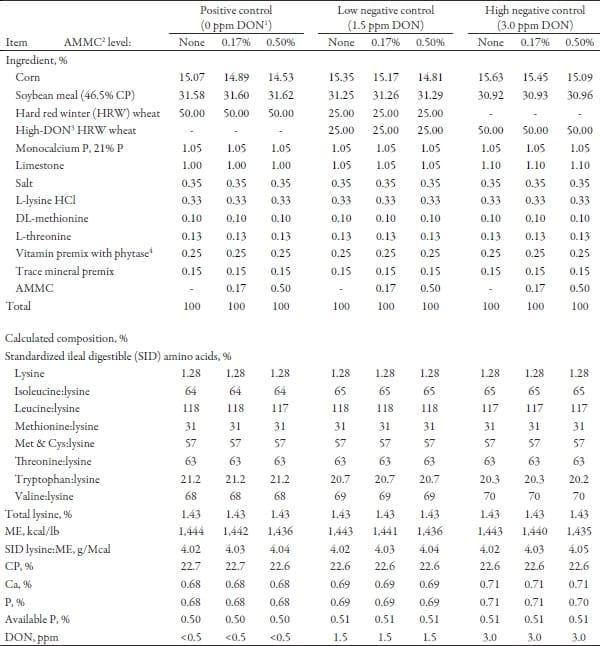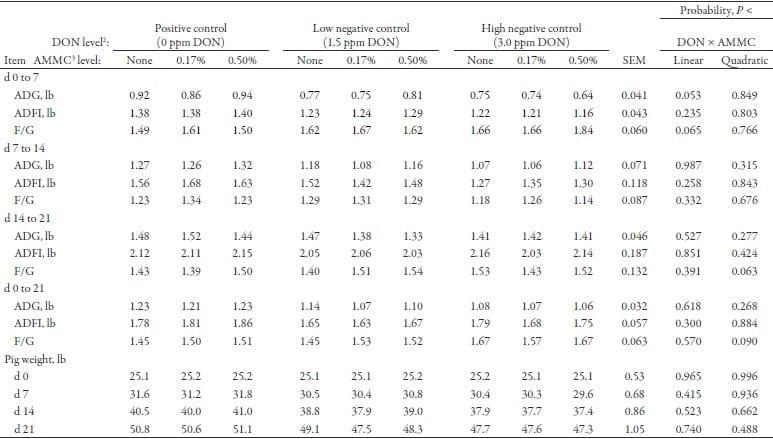Introduction
Deoxynivalenol (DON), also known as vomitoxin, is a mycotoxin commonly found in wheat, corn, and other cereal grains. During wet, cool periods of the growing season, Fusarium graminearum forms a head blight, producing DON as a secondary metabolite. Because DON occurs frequently and at toxicologically relevant concentrations and pigs are the most susceptible livestock species, it is one of the most important mycotoxins for swine producers to be aware of. At low concentrations (<1 ppm), DON causes decreased feed intake and upregulation of the immune system; at high levels (>10 ppm), it can cause complete feed refusal and vomiting. Deoxynivalenol remains challenging for livestock producers because commonly used detoxifying agents such as bentonite clay and activated aluminosilicates, which are known to be effective against aflatoxins, are largely ineffective against DON. These additives may be ineffective against DON because the DON molecule is too large to become trapped within the clay matrix. However, it is hypothesized that an algae-modified montmorillonite clay (AMMC) to incorporate algae polysaccharides and expand the layers of the clay, may alleviate the growth reductions associated with feeding DON-contaminated grains. Therefore, the objective of this study was to evaluate the effects of currently recommended levels of AMMC on the growth performance of nursery pigs fed diets containing low levels of DON.
Procedures
The Kansas State University Institutional Animal Care and Use Committee approved the protocol used in this experiment. The trial was conducted at the K-State Segregated Early Weaning Facility in Manhattan, KS. A total of 360 barrows (PIC 1050; 25.1 ± 0.5 lb and 45 d of age) were used in a 21-d experiment with 8 replicate pens per treatment and 5 pigs per pen.
Pigs were shipped to the facility immediately postweaning and placed in 2 identical nurseries, each containing 40 pens (5 ft × 5 ft). Upon arrival, pigs were placed in pens by weight and fed a common diet until approximately 25 lb.
On d 0, pigs were re-weighed and pens were randomly assigned to 1 of 9 dietary treatments in a 3 × 3 factorial arrangement with DON and AMMC inclusion as main effects (Table 1). The 9 dietary treatments consisted of 3 positive control (PC) diets without DON with 0, 0.17%, or 0.50% AMMC added, 3 low negative control (Low NC; 1.5 ppm DON) diets with 0, 0.17%, or 0.50% AMMC, and 3 high negative control (High NC; 3 ppm DON) diets with 0, 0.17%, or 0.50% AMMC. The AMMC is typically recommended to be included at 0.17% and was added at the expense of corn in diet formulation. Diets exceeded NRC (20125) nutrient requirements, and apart from the inclusion of DON and AMMC were formulated to be identical in nutrient composition.
Table 1. Formulated diet composition (as-fed basis.
1 Deoxynivalenol (DON).
2 AMMC algae-modified montmorillonite clay product.
3 Analyzed DON concentration in wheat was 6.03 ppm at LDA Laboratories (Ploufragan, France).
4 Phyzyme 600 provided 750 phytase units (FTU) phytase/kg and 0.13% available P released.
Diets were manufactured in meal form at the K-State O. H. Kruse Feed Mill in Manhattan, KS. Hard red winter wheat naturally contaminated with DON was sourced (Table 2; 6.03 ppm DON) and incorporated into diets to achieve desired dietary DON levels. Prior to diet manufacturing, a total of 60 subsamples were collected from both a high-DON and DON-free wheat source. These samples were homogenized and split into duplicate samples, which were then sent for mycotoxin analysis at NDSU (North Dakota State University Veterinary Diagnostic Laboratory, Fargo, ND) and LDA Labs (Ploufragan, France). The lab at NDSU conducted an 18-component toxin screen using a combination of mass spectrometry, ELISA, and HPLC. LDA Labs performed a 43-component toxin screen using high-pressure liquid chromatography/mass spectrometry analyses. Due to concerns that high-DON wheat may also have a different amino acid profile than DON-free wheat, both wheat sources were analyzed for amino acid content (Table 3) at the University of Missouri Agricultural Experiment Station Chemical Laboratories (Columbia, MO), and diet formula tion was adjusted to account for the differences. Following final diet manufacturing, diet samples were sent to NDSU and the University of Missouri for mycotoxin (Table 4) and proximate analysis (Table 5).
Table 2. Mycotoxin analysis of basal ingredients

1 Deoxynivalenol (DON).
2 North Dakota State University Veterinary Diagnostic Laboratory (Fargo, ND). Samples were sent for 18-component mycotoxin analysis and analyzed using a variety of mass spectrometry, ELISA, and HPLC methods. Included in the table are mycotoxins found at levels above detection limits.
3 LDA Labs (Ploufragan, France). Samples analyzed using a 43-component toxin screen using liquid chromatography/mass spectrometry analysis methods. Included in the table are mycotoxins found at levels above detection limits.
4 (---) indicates samples were not tested.
Table 3. Nutrient analysis of basal ingredients (as-fed basis)1

1 Samples were analyzed at the University of Missouri Agricultural Experiment Station Chemical Laboratories (Columbia, MO).
2 Deoxynivalenol (DON).
Table 4. Mycotoxin analysis of experimental diets (as-fed basis)1

1 Diet samples were analyzed at North Dakota State University Veterinary Diagnostic Laboratory (Fargo, ND). An 18-component mycotoxin analysis was conducted using a variety of mass spectrometry, ELISA, and HPLC methods. Included in the table are mycotoxins found at levels above detection limits.
2 Deoxynivalenol (DON).
3 AMMC. Algae-modified montmorillonite clay.
Table 5. Nutrient analysis of experimental diets (as-fed basis)1

1 Samples were analyzed at the University of Missouri Agricultural Experiment Station Chemical Laboratories (Columbia, MO).
2 Deoxynivalenol (DON).
3 AMMC. Algae-modified montmorillonite clay.
Average daily gain, ADFI, and F/G were determined by weighing pigs and determining feed disappearance on d 0, 7, 14, and 21 (Tables 6 and 7). Each pen contained a 4-hole, dry self-feeder and a nipple waterer to provide ad libitum access to feed and water.
Table 6. Effects of an algae-modified montmorillonite clay (AMMC) on growth performance of nursery pigs fed diets contaminated with low levels of deoxynivalenol (DON)1
1 A total of 360 barrows (PIC 1050; initially 25.1 lb and approximately 45 d of age) were used in a 21-d experiment with 8 replicate pens per treatment and 5 pigs per pen. All diets were fed in meal form.
2 Denotes formulated levels. Wheat naturally contaminated with DON (6.03 ppm) was used to incorporate DON into diets at desired concentrations.
3 AMMC. Algae-modified montmorillonite clay.
Table 7. Main effects of deoxynivalenol (DON) and algae-modified montmorillonite clay (AMMC) on nursery pig performance1
1 A total of 360 barrows (PIC 1050; initially 25.1 lb and approximately 45 d of age) were used in a 21-d experiment with 24 replicate pens per treatment and 5 pigs per pen. All diets were fed in meal form.
2 Denotes formulated levels. Wheat naturally contaminated with DON (6.03 ppm) was used to incorporate DON into diets at desired concentrations.
3 AMMC. Algae-modified montmorillonite clay.
Data were analyzed using the MIXED procedure of SAS (SAS Institute, Inc., Cary, NC) with the main effects and their interactions serving as fixed effects and barn as a random effect. Means were evaluated using preplanned linear and quadratic orthogonal contrasts. The coefficients for the unequally spaced linear and quadratic contrasts were derived using the IML procedure in SAS. Least squares means were calculated for each independent variable. Results were considered significant if P-values were ≤ 0.05 and tendencies if 0.05 > and P ≤ 0.10.
Results and Discussion
Proximate and amino acid analysis of DON-contaminated wheat revealed protein and amino acid levels marginally but consistently higher than the DON-free wheat source. Fusarium pathogens are known to not only produce secondary metabolites such as mycotoxins but also alter the nutrient content of the affected grain source.6 Because these alterations in nutrient content are inconsistent, it is critical to account for these differences in diet formulation to assess the true impact of mycotoxin contamination on animal performance.
In the present study, analyzed DON concentrations in the naturally DON-contaminated wheat differed between NDSU (8.4 ppm) and LDA Labs (6.03 ppm). Although very low levels of several other mycotoxins were detected in the DON-contaminated wheat source, the levels observed were below concentrations necessary to elicit reductions in animal performance due to individual toxin exposure; however, the impact of interactive effects between toxins cannot be completely excluded. To ensure that final diet DON levels were adequate to achieve a DON-associated reduction in performance, the analysis from LDA Labs was used as the basis for diet formulation. Analyzed DON in the final diets revealed levels that were within 20% of the targeted DON level, averaging 1.73 and 3.20 ppm for the 1.5 and 3.0 ppm targets, respectively. Furthermore, proximate analyses of the final diets were generally in line with formulated levels.
Regarding growth performance, a tendency for a DON × AMMC interaction (linear, P < 0.10) was observed for d 0 to 7, where increasing AMMC tended to improve ADG in PC and low-NC diets but tended to decrease ADG in high-NC diets. This interaction for ADG appeared to be driven by a tendency for a F/G interaction (linear, P < 0.10) in which increasing AMMC inclusion worsened feed efficiency in high-NC diets whereas feed efficiency remained similar in pigs fed PC and low-NC diets regardless of AMMC inclusion. Furthermore, a tendency for a DON × AMMC interaction for feed efficiency (quadratic, P < 0.10) was observed from d 14 to 21 and overall (d 0 to 21), where increasing AMMC in PC and low-NC diets worsened feed efficiency, whereas in high-NC diets increasing AMMC initially improved but subsequently worsened F/G at the 0.50% inclusion rate.
For the main effects of DON on nursery pig growth, results matched expected reductions in ADG, where pigs experienced the most deleterious effects of DON during the initial exposure period and seemed to attenuate somewhat over time. During d 0 to 7, ADG decreased (linear, P < 0.001) as DON was increased in diets, driven by both a decrease in feed intake (linear, P < 0.001) and a worsening of feed efficiency (linear, P < 0.001). These responses were expected because they are known to be associated with upregulation of the immune system during initial exposure. From d 7 to 14, reduced feed intake (quadratic, P < 0.001) continued to drive ADG lower (linear, P < 0.001) in pigs fed increasing concentrations of DON. However, increasing DON in the diets improved (quadratic, P < 0.01) feed efficiency, which may be attributed to improved nutrient utilization at such low feed intake. Nevertheless, from d 14 to 21, the previously observed negative effects of DON on nursery pig growth were less marked. Although there was a tendency for reduced ADG (linear, P < 0.10) as DON increased, ADFI and feed efficiency were similar across treatments. Overall (d 0 to 21), increasing DON concentration in nursery pig diets caused a reduction in ADG and BW (linear, P < 0.001), which was driven by lower ADFI (quadratic, P < 0.01) and poorer feed efficiency (quadratic, P = 0.01).
Although increasing DON in nursery pig diets resulted in the expected reductions in growth necessary to evaluate the potential effectiveness of a DON-detoxifying agent, the addition of AMMC at 0.17 and 0.50% did not affect ADG, ADFI, feed efficiency, or final pig BW during the experimental period.
In conclusion, although AMMC does not appear to offset the deleterious effects of low levels of DON in nursery pig diets, the results of this study indicate that minimizing DON contamination in swine diets is critical, because even low dietary levels (1.5 to 3.0 ppm) can result in growth performance reductions of 10% or greater. Correcting suboptimal field conditions to minimize DON concentration is impractical, so additional research is necessary to identify practical and effective methods to reduce the negative effects of deoxynivalenol postharvest.
This article was originally published in KSU Swine Day 2014 report. P.53-62.
 1 Deoxynivalenol (DON).
1 Deoxynivalenol (DON). 1 Samples were analyzed at the University of Missouri Agricultural Experiment Station Chemical Laboratories (Columbia, MO).
1 Samples were analyzed at the University of Missouri Agricultural Experiment Station Chemical Laboratories (Columbia, MO). 1 Diet samples were analyzed at North Dakota State University Veterinary Diagnostic Laboratory (Fargo, ND). An 18-component mycotoxin analysis was conducted using a variety of mass spectrometry, ELISA, and HPLC methods. Included in the table are mycotoxins found at levels above detection limits.
1 Diet samples were analyzed at North Dakota State University Veterinary Diagnostic Laboratory (Fargo, ND). An 18-component mycotoxin analysis was conducted using a variety of mass spectrometry, ELISA, and HPLC methods. Included in the table are mycotoxins found at levels above detection limits. 1 Samples were analyzed at the University of Missouri Agricultural Experiment Station Chemical Laboratories (Columbia, MO).
1 Samples were analyzed at the University of Missouri Agricultural Experiment Station Chemical Laboratories (Columbia, MO).











